Let’s get serious–we know the average sales increases by as much as 2 times when the product goes from zero reviews to at least one review. The thing is most businesses know the value of getting more reviews, but they simply struggle on how to ask for reviews.
Retailers have to adopt the mentality of the more, the merrier because positive reviews are not just an ego boost–they represent serious positioning power. According to multiple online shopping statistics and studies, well over 90% of consumers look at online reviews before making a purchase.
Translation? The more reviews you have to show off your satisfied customers, the easier it is to convince prospects your products are the real deal. If nothing else, customer feedback clues you in on what your current and future customers want to see you offer.
Here’s the problem, though–reviews don’t happen by accident.
If you want customers to leave meaningful feedback, you have to learn how to ask for reviews. That’s why we put together this guide on how to ask for reviews without chasing them down one by one.
The Art of Asking for Customer Reviews
Food for thought: 70% of people are willing to write a review if prompted to do so. In other words, you shouldn’t be shy about asking for reviews. But the question isn’t whether or not you should ask for reviews, but rather how to ask for ‘em.
Your parents probably taught you to say “please” and “thank you,” right? Well, figuring out how to ask for reviews is a bit more complicated than that.
For example, how do you avoid coming off as clingy or desperate? Is there an ideal time to pitch your customers for reviews? What the heck do you even say? All great questions!
Before we dive into specific strategies, let’s talk about the art of asking. The following tips are around language, framing and timing so you understand what makes a review pitch pack a punch. These tips are fair game for emails, review-specific promotions and even scripts for your customer service team!
Give Your Customers a ‘Why’
Writing reviews might seem like a simple, straightforward task for your satisfied customers. The reality is reviews represent an exchange. After all, you’re asking them to do something before their initial transaction.
https://www.instagram.com/p/6QpV-Ujq46/
Chances are your customers are crazy busy. Ask yourself: what would compel you to take time from your schedule to write a review? Offering an awesome product or service is a start, but you should strive to give your customers an answer to “Why bother?”
“We want to make sure that we’re delivering top-tier products and to understand if there’s anything we can do to improve in the future!”
These sorts of statements provide subtle yet significant context to your review questions and make them seem less obtrusive.
Frame Your Reviews as Quick & Painless
Reviews shouldn’t be seen as something to tack on your customers’ to-do list. Ideally, they should be empowered to leave feedback quickly and without having to jump through too many hoops.
And no, a “good” review doesn’t have to be novel-length (but more on that later). Something as simple as the following phrase can win over a customer who’s on the fence about writing a review:
“Your feedback is invaluable to us and only takes a few seconds!”
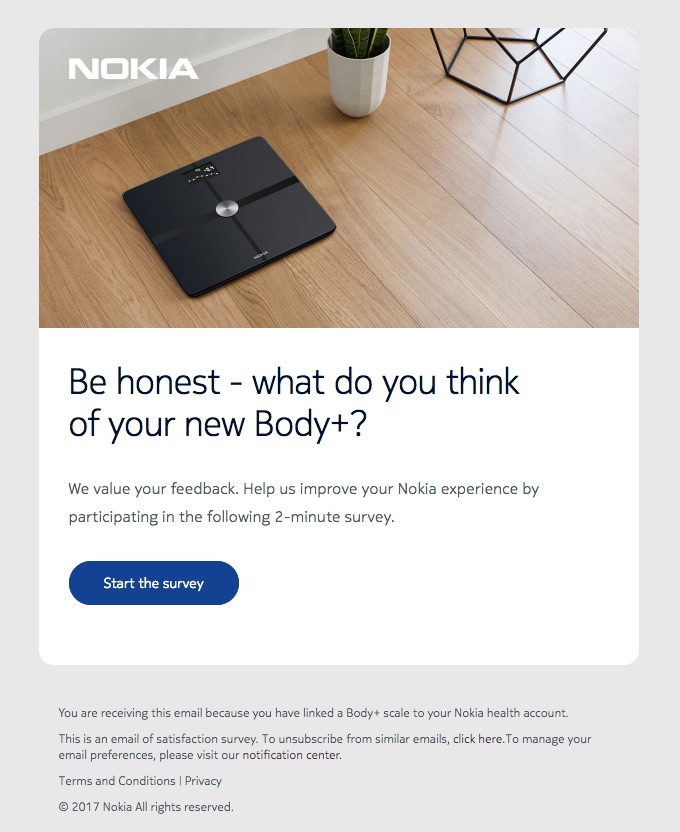
In fact, this is the exact sort of approach that Nokia takes for their post-purchase review request emails. See how that works?
Mind Your Words
Figuring out how to ask for reviews might seem simple on the surface. However, writing your first review request pitch can certainly be daunting.
The good news? Asking for a review doesn’t have to be rocket science. As you brainstorm your pitch, just keep the following three principles in mind:
- Start with a question. Review requests centered around questions like what did you think of tend get more responses. Questions manage to engage your customers from the word “go” and naturally prompt a response.
- Make your pitch about them, not just you. Again, make sure to drive home the point that you’re eager to hear from your customers because you want to provide the best service possible. You’re doing this to help your customers too.
- Be straightforward. There’s no point in being vague or coy when asking for a review. Customers are more than happy to write them, but probably see their fair share of requests too. You don’t need more than a couple of sentences to get the job done.
Time Your Reviews Requests to Perfection
This is a crucial piece of how to ask for reviews that’s easy to overlook. Ever been to a restaurant where a waiter or manager asks you how your food was before you’ve even had a chance to take a bite?
Awkward, right?
Likewise, you can’t be too eager when it comes to asking for reviews. You don’t want to ask someone how they’re enjoying your product before they’ve had a chance to do so.
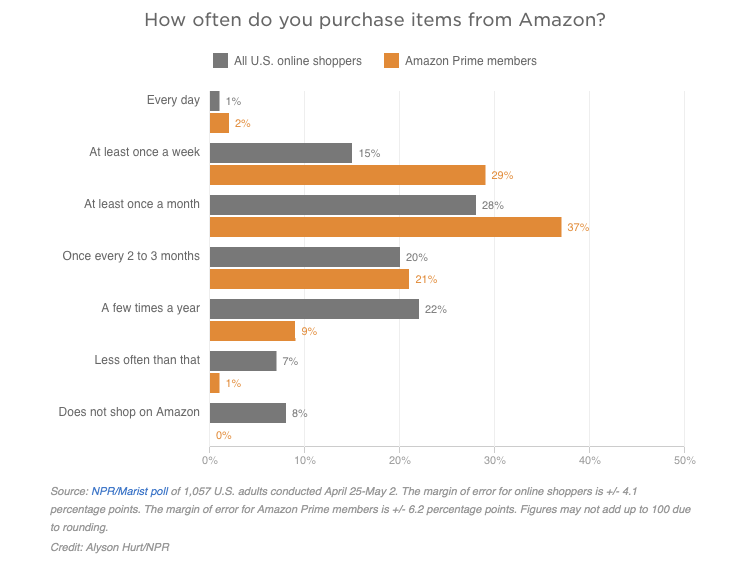
And on the flip side, shoppers order a lot of products online. In fact, an NPR report found 28% of U.S. shoppers order at least one product off Amazon a week!
You shouldn’t wait too long and risk losing the interest and initial buzz behind their purchase. For most products and industries, a week or two is fair game in terms of how long to wait before asking for a review.
For reference, MailChimp’s default trigger settings for a post-purchase message series (hint: where a review request would be) are an hour, 10 days and 20 days after a purchase is made. The latter two times would work for most businesses out there.
If you’re still having trouble asking for reviews and actually getting them, we’ve got you. PowerReviews’ Progressive Collection feature allows you to put the products that need reviews at the top of post-purchase emails.
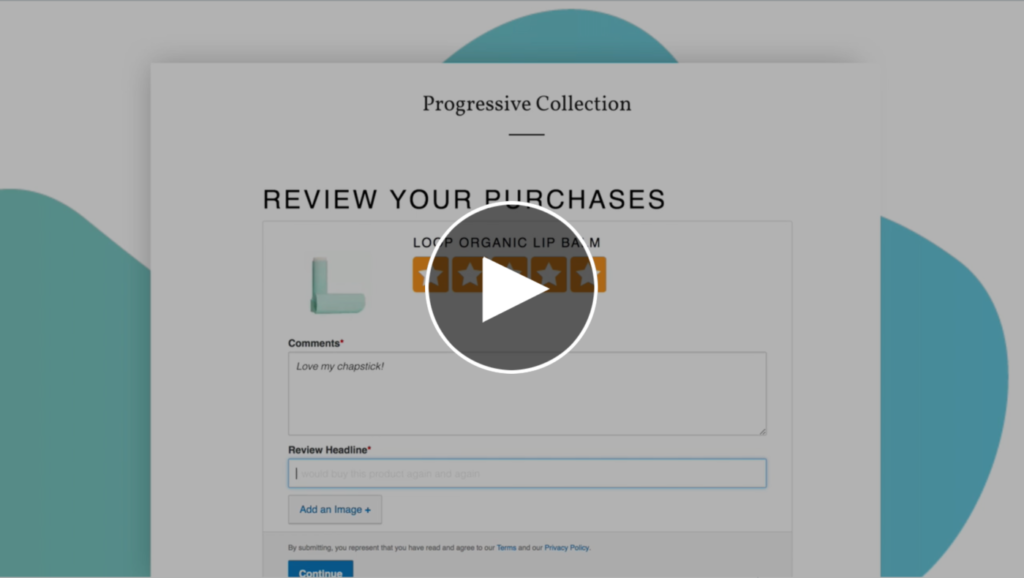
This is perfect for retailers who often see multi-item orders, but don’t see the reviews for all items. If a shopper bought a toothbrush, hairbrush and hair-dying kit, you’d probably want the customer to write that review for the dye above all.
Our collection features lets your customers see review requests forms showing the most expensive item or lowest review count item first in the review submission. Request a demo to learn how else PowerReviews helps increase review rates!
5 Strategies for Encouraging More Customer Reviews
Now that we’ve broken down the art of asking, let’s talk about how to ask customers to reviews. Like, what are the best ways to actually, you know, ask?
Below are 5 tips on how to encourage customers to write reviews and specific tactics that should be part of your various marketing campaigns:
1. Put Together Your Post-Purchase Autoresponders
Email is perhaps the most popular avenue for asking for reviews. It’s no secret as to why, either.
For starters, you’re able to put review quests can be put on autopilot. Just about any major email marketing software includes a post-purchase series which means all you need to do is put together a pitch email to slot in.
The beauty of automated review emails is that you can perfect and optimize your pitch prior to sending it. No awkward conservations: just a sleek, straightforward message to encourage reviews.
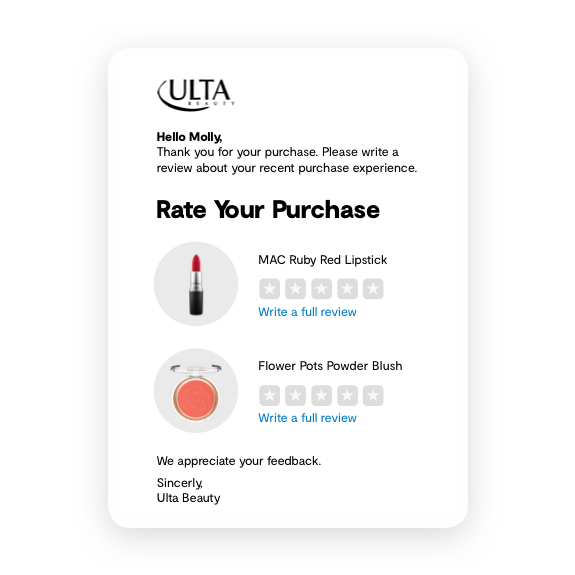
By setting up your post-purchase email requests automatically, you ensure that you hit up all of your customers for reviews. This results in a higher overall volume of reviews and no second-guessing who you’ve already asked.
Of course, email autoresponders sometimes feel robotic or pushy if they aren’t crafted with care. That’s exactly why we believe your messages need to have a personal touch and be sent at an appropriate time so they don’t land in the trash (or worse, the spam folder).
However, the key is making an autoresponder that doesn’t annoy someone. This is where the art of asking comes into play as you ask in a reasonable frame of time and don’t want to come off as aggressive or pushy. Flooding someone’s inbox is a bad look and isn’t going to get you much love.
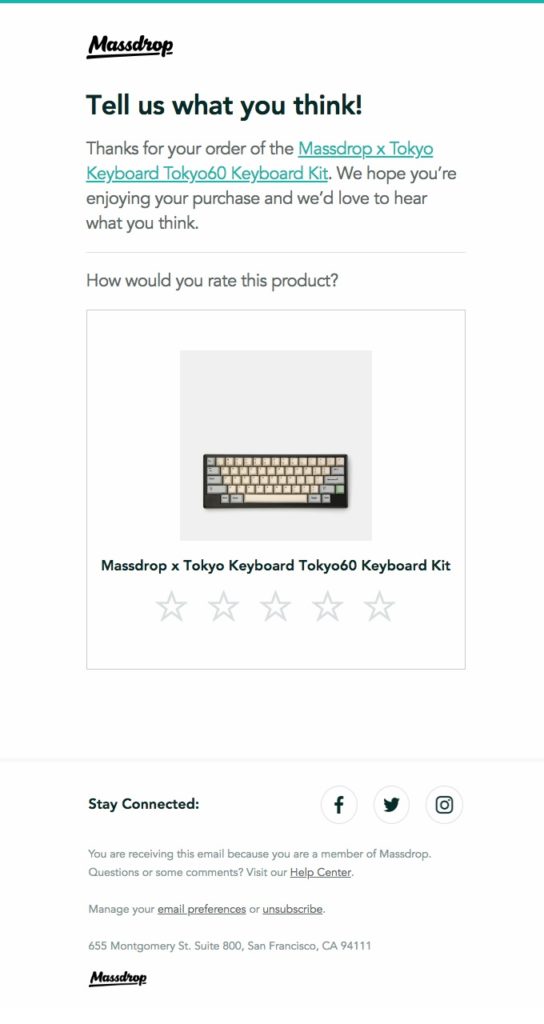
This is a great example of an effective post-purchase email from Massdrop. Short, sweet and to the point, this messages presents itself as a positive request that isn’t going to eat up the customer’s schedule.
2. Sweeten the Deal With Review Incentives
Either as a variation on your autoresponders or as part of a specific promotion, consider providing your customers with incentives as part of your review requests. Remember what we said earlier about giving customers a “Why bother?”
A freebie such as a percentage-off discount or entry into a contest can do the trick. The point here isn’t to break the bank or to come off as fake with your review content. Instead, the right incentive simply helps encourage shoppers to leave a review and possibly even another purchase.
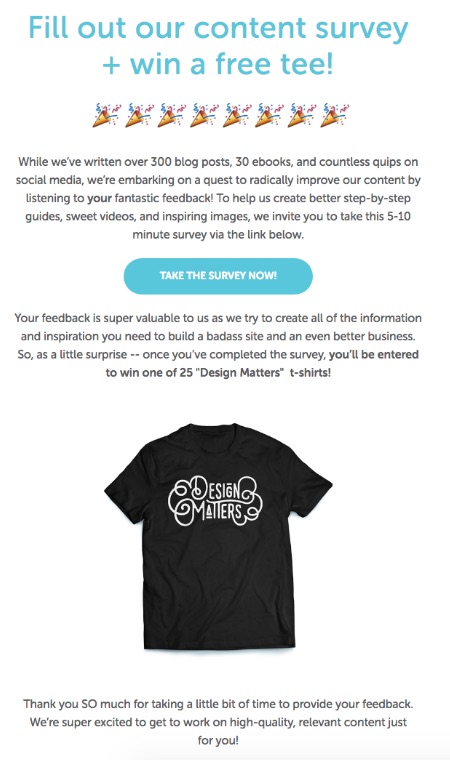
If a discount isn’t doing the trick, consider the power of a product sampling campaign. PowerReviews’ Influencer and Social Suite connects brands to our massive community of everyday influencers who are ready to leave reviews for your products, shout them out on social media and potentially turn them into repeat buyers.
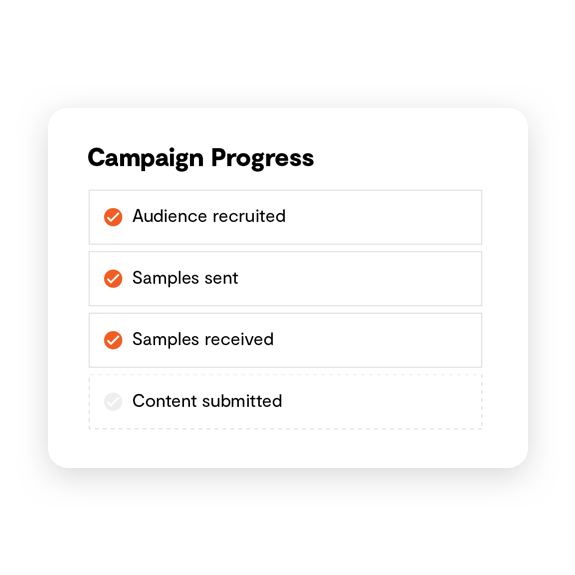
Product sampling is one of the best ways to ask for reviews–especially when you have a new product or low-rated item in need of some reviews.
3. Prompt Your Customers With Review Templates
The more straightforward your review process, the better. That’s exactly why we integrate specific questions and prompts into our review platform.
Think about what it’s like to stare a totally blank page when trying to write, well, anything. Having some form of guidance is enough to get you going.
For example, PowerReviews’ Review Snapshot feature breaks down specific ratings and relevant keywords in addition to providing an open-ended section where reviewers can speak their mind. This gives you the best of both worlds in terms of feedback.
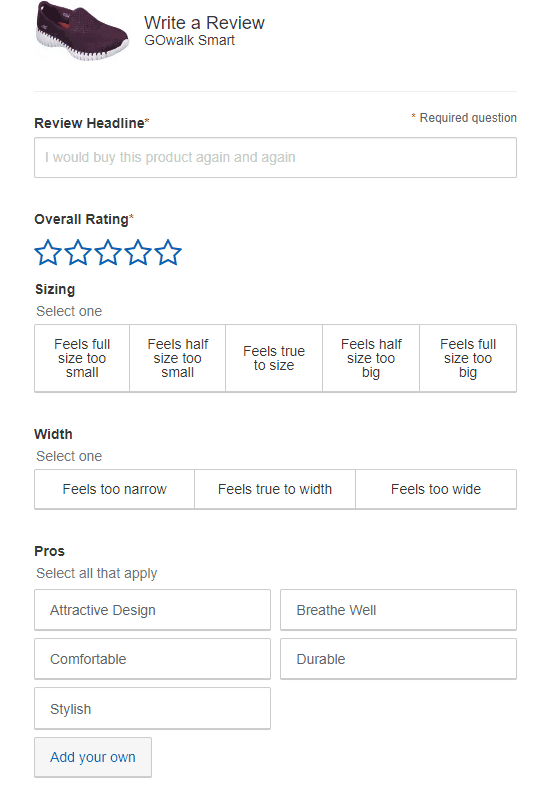
The best part is each brand has the option to select which questions or product details it includes on the Review Snapshot. This means your customers have a tailored experience and the freedom to say what they need to say, all the while you have actionable data points that clue you in on the most important details of your products. In short, a win-win.

4. Monitor Your Social Mentions & Share Customer Content
More customers are taking to social media to shout-out their latest purchases. As a result, it pays to mind your social mentions to see when your buyers are showing you some love.
These represent perfect opportunities to ask for on-site reviews. If someone’s willing to hype you up on social media, they’ll more than likely put in a good word, no questions asked.
To encourage more of these types of shout-outs, make a point to share customer photos and user-generated content on a regular basis. If followers and customers know that you frequently promote your fans, they’ll naturally want to get on board.
Think of it as a sort of snowball effect.
Hint: PowerReviews makes it a cinch for you to discover and obtain the rights to your user-generated content. In addition to helping you monitor your mentions, our platform taps into customer photos that are perfect to couple with your on-site reviews. Want to see all of our Social Collection capabilities? Request a demo today!
5. Be Transparent By Responding to Reviews & Questions
If you expect your customers to provide feedback and answer questions regarding your products, you should be willing to do the same. Responding to questions and reviews signals that you’re actively listening to your customers and are truly committed to stellar service.
Encouraging customer interactions isn’t just a one-way street. Making your transparent and open, responding to both positive and negative feedback, is a good look for your brand.
Anyone who’s willing to ask a question is likely the same type of person to write a review once they’ve made a purchase.
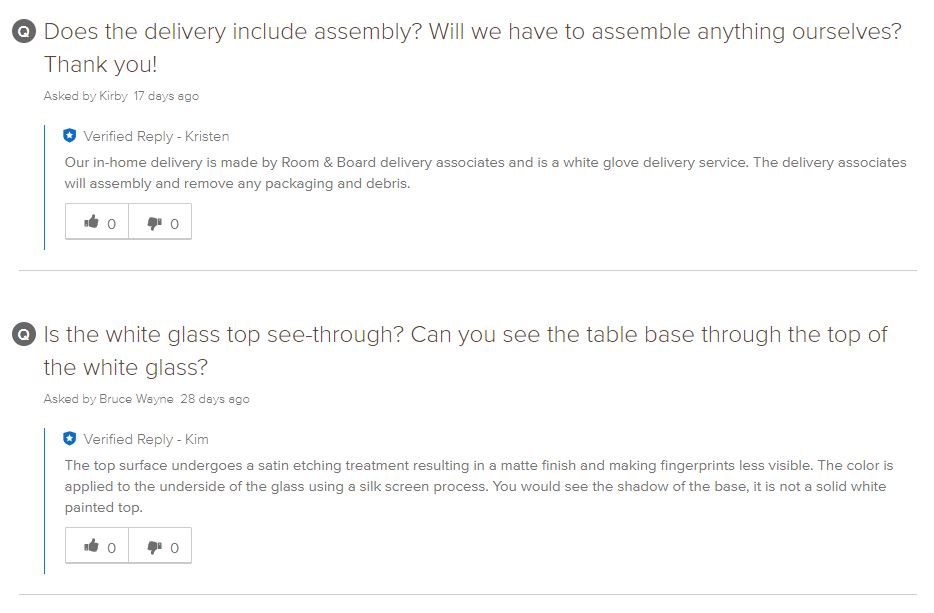
PowerReviews’ Questions and Answers platform enables prospects to ask questions which you can reply to for the sake of winning more would-be customers.
How Do You Ask Customers for Reviews?
Listen: there is no secret to scoring more reviews.
If you want ‘em, you’re going to have to ask for ‘em.
The tips and tactics in this guide can put you on a path toward consistent positive feedback for your business.
And with the help of platforms like PowerReviews, you know that you’re maximizing the engagement and level of detail from your customer feedback.













